

Www.loc.gov/teachers/classroommaterials/primarysourcesets/assimilation/pdf/teacher_guide.pdf. Indian Boarding Schools: Assimilation through Education - Primary Source Set. Students - Procedure - Indian Boarding Schools - Lesson Plan. Back to Lesson Plans The following people had experiences with the American Indian boarding schools.
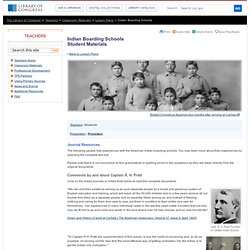
You may learn more about their experiences by selecting the complete text link. Please note that it is not uncommon to find grammatical or spelling errors in the quotations as they are taken directly from the original documents. Comments by and about Captain R. H. Click on the linked journals or linked texts below to read the complete documents. Capt. "We can end their existence among us as such separate people by a broad and generous system of English education and training, which will reach all the 50,000 children and in a few years remove all our trouble from them as a separate people and as separate tribes among us, and instead of feeding, clothing and caring for them from year to year, put them in condition to feed clothe and care for themselves. Origin and History of work at Carlisle.[ The American missionary./ Volume 37, Issue 4, April 1883] Nez Perce Chief Joseph with General O.O.
Native American - Removal from their Land - Immigration...- Classroom Presentation. Removing Native Americans from their Land President Andrew Jackson offered similar rhetoric in his first inaugural address in 1829, when he emphasized his desire “to observe toward the Indian tribes within our limits a just and liberal policy, and to give that humane and considerate attention to their rights and their wants which is consistent with the habits of our Government and the feelings of our people.”
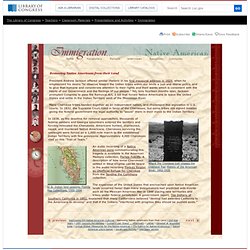
Yet, only fourteen months later, Jackson prompted Congress to pass the Removal Act, a bill that forced Native Americans to leave the United States and settle in the Indian Territory west of the Mississippi River. Many Cherokee tribes banded together as an independent nation, and challenged this legislation in U.S. courts. In 1832, the Supreme Court ruled in favor of the Cherokees, but some tribes still signed treaties giving the federal government the legal authority to "assist" them in their move to the Indian Territory. Teachers - Procedure - Indian Boarding Schools - Lesson Plan. Back to Lesson Plans Lesson Procedure This project is intended to encourage students to reflect on the multiple facets of the forced acculturation of the Native Americans during the late 19th and into the 20th century.
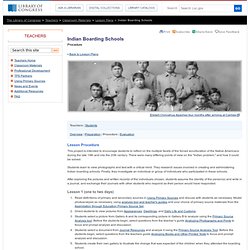
There were many differing points of view on the "Indian problem," and how it could be solved. Students learn to view photographs and text with a critical mind. They research issues involved in creating and administering Indian boarding schools. After exploring the pictures and written records of the individuals chosen, students assume the identity of the person(s) and write in a journal, and exchange their journals with other students who respond as their person would have responded. Lesson 1 (one to two days) Read definitions of primary and secondary sources in Using Primary Sources and discuss with students as necessary.
Lesson 2 (one to three days) Top Lesson 3 (one to two days) Extension. Teachers - Preparation - Indian Boarding Schools - Lesson Plan. Indian Country Diaries . History . Indian Boarding Schools. Nichole Garcia at graduation from Sherman High School For Pratt, it was an opportunity to try out his new ideas about education.
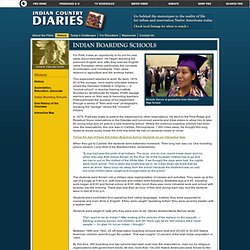
He began teaching the prisoners English and, after they learned English came European ideas, particularly the concepts of civilization and Christianity. Then came lessons in agriculture and the working trades. This experiment seemed to work. By April, 1878, 62 of the younger, more easily educated Indians joined the Hampton Institute in Virginia — a "normal school" or teacher training institute founded by abolitionists for blacks. In 1879, Pratt was ready to extend the experiment to other reservations. Follow the trail of these first Indian Boarding School Students on our Interactive Map. When they got to Carlisle, the students were extremely homesick. "[Long hair] was the pride of all Indians. The students were thrown into a military style regimentation of classes and activities. Students were prohibited from speaking their native languages.
Page 1 | 2. American Indian Boarding Schools Haunt Many. Teachers - Overview - Indian Boarding Schools - Lesson Plan. Back to Lesson Plans Lesson Overview In the late 1800s, the United States supported an educational experiment that the government hoped would change the traditions and customs of American Indians.
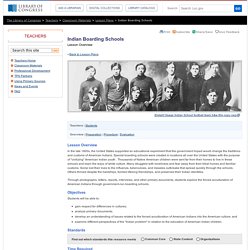
Special boarding schools were created in locations all over the United States with the purpose of "civilizing" American Indian youth . Thousands of Native American children were sent far from their homes to live in these schools and learn the ways of white culture. Many struggled with loneliness and fear away from their tribal homes and familiar customs. Through photographs, letters, reports, interviews, and other primary documents, students explore the forced acculturation of American Indians through government-run boarding schools.
Objectives Students will be able to: Standards Time Required Two weeks Recommended Grade Level Topic American Indian History Era Rise of Industrial America, 1876-1900 Progressive Era to New Era, 1900-1929.